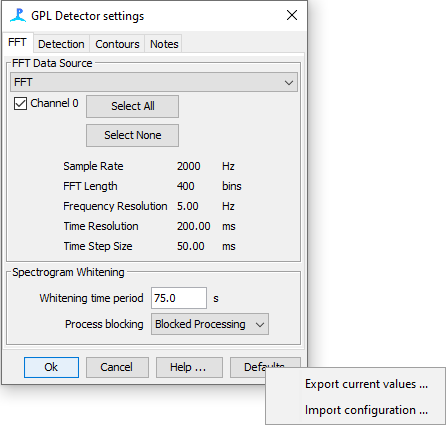Defaults
Default values for different species can be imported and exported from xml files using the drop down menu which shows when you click on the Defaults button.

The configuration files are in xml format, which means that they can be opened and read with most text editors and easily imported into other software, such as R or Matlab.
A selection of standard GPL configurations can be downloaded here.
Note that the configuration files only contain information about the GPL detection parameters and do not contain information about the sample rate and FFT length of the data that the GPL detector is connected to.
Sample rate and FFT length are important, since they control the time and frequency resolution of the data coming into the detector.
You should adjust the FFT (Spectrogram) Engine parameters so that they are appropriate for the species you’re trying to detect, including a Decimator module if necessary to provide data at the right sample rate. If a sample rate is many times the frequency of the sound you’re interested in, then you may find you need a very long FFT length to get a sensible time and frequency resolution.
The frequency resolution of a spectrogram, in Hz, is the acoustic sample rate divided by the FFT Length.
The time resolution and time step size, in seconds, are the FFT Length and FFT Hop divided by the sample rate.
This means that data with a sample rate of 2000 Hz, and FFT length of 2048 samples and an FFT hop of 128 samples will have time and frequency resolutions of 64ms and 0.98 Hz respectively. Exactly the same time and frequency resolutions could be achieved with data sampled at 1000Hz if you were to use an FFT length of 1024 samples and FFT hop of 64 samples.
Nominal values for these parameters that have been used in the past are provided below.
Note that PAMGuard does support FFT lengths which are not an exact power of 2, however such values may mean that the FFT’s are slow to compute which may impact on processing speed.
| Species | Sample Rate | FFT Length | FFT Hop |
|---|---|---|---|
| Blue Whale D | 2000 Hz | 2048 | 128 |
| Fin Whale 20Hz | 2000 Hz | 2048 | 128 |
| Fin Whale 40Hz | 2000 Hz | 2048 | 128 |
| Humpback | 2000 Hz | 2048 | 128 |
| Bryde’s whale | 6000 Hz | 4096 | 512 |